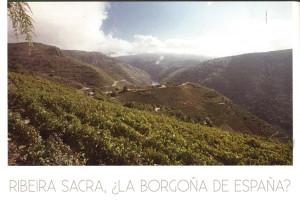Burgundy = Ribera Sacra? I think not!
May 25th, 2016 | Odds & Sods
I read a Spanish wine publication recently (which shall remain nameless), where one of the articles named our neighbouring wine region of Ribera Sacra as ‘the Burgundy of Spain’. As someone who knows Burgundy really quite well (having travelled there extensively for about 14 years during my wine career), this startling headline certainly caught my eye. What on earth could they possibly mean, I thought to myself? Is the geography similar? Do they grow Pinot Noir (or Chardonnay for that matter)? Are the climates similar? What could the connection possibly be?
Certainly it’s true that the history of Ribera Sacra dates back to the spread of the Roman Empire across Europe (the resulting vine cultivating practices subsequently perpetuated by the church), but then the same can be said of many a wine region throughout Europe. As far as I can see however, in reading this article, this is where any similarity begins and ends.
The Ribera Sacra vineyards cling to the steep sided valley of the River Sil, where the most common grape varieties cultivated are Mencia and the Alicante Bouschet – a typography much more akin to the Douro Valley than the rolling hills of Burgundy. The resulting wines are also very different – I really adore some of the great wines of Burgundy, both red and white, whereas wines of the Ribera Sacra don’t really excite me at all. Indeed, during my time here I have only really found one or two that I would consider worth drinking a second time.
The final thought of the author was to say that he was convinced that the wines produced in Ribera Sacra could easily share “the delicacy and finesse of the Grand Crus of Burgundy”! The only conclusion I could draw upon reading this was either that the writer had never tasted a Burgundy Grand Cru, or that he must be on drugs!
[:es] I read a Spanish wine publication recently (which shall remain nameless), where one of the articles named our neighbouring wine region of Ribera Sacra as ‘the Burgundy of Spain’. As someone who knows Burgundy really quite well (having travelled there extensively for about 14 years during my wine career), this startling headline certainly caught my eye. What on earth could they possibly mean, I thought to myself? Is the geography similar? Do they grow Pinot Noir (or Chardonnay for that matter)? Are the climates similar? What could the connection possibly be?
I read a Spanish wine publication recently (which shall remain nameless), where one of the articles named our neighbouring wine region of Ribera Sacra as ‘the Burgundy of Spain’. As someone who knows Burgundy really quite well (having travelled there extensively for about 14 years during my wine career), this startling headline certainly caught my eye. What on earth could they possibly mean, I thought to myself? Is the geography similar? Do they grow Pinot Noir (or Chardonnay for that matter)? Are the climates similar? What could the connection possibly be?
Certainly it’s true that the history of Ribera Sacra dates back to the spread of the Roman Empire across Europe (the resulting vine cultivating practices subsequently perpetuated by the church), but then the same can be said of many a wine region throughout Europe. As far as I can see however, in reading this article, this is where any similarity begins and ends.
The Ribera Sacra vineyards cling to the steep sided valley of the River Sil, where the most common grape varieties cultivated are Mencia and the Alicante Bouschet – a typography much more akin to the Douro Valley than the rolling hills of Burgundy. The resulting wines are also very different – I really adore some of the great wines of Burgundy, both red and white, whereas wines of the Ribera Sacra don’t really excite me at all. Indeed, during my time here I have only really found one or two that I would consider worth drinking a second time.
The final thought of the author was to say that he was convinced that the wines produced in Ribera Sacra could easily share “the delicacy and finesse of the Grand Crus of Burgundy”! The only conclusion I could draw upon reading this was either that the writer had never tasted a Burgundy Grand Cru, or that he must be on drugs![:]


